Las plantas de yuca son una parte esencial del paisaje del sureste de los EE. UU. y se alinean en los bordes de las carreteras y en áreas áridas abiertas por millas para ver. También son una adición popular a la xerojardinería y los jardines interiores, pero muchas personas desconocen su diversidad y facilidad de cuidado. Aquí reunimos las opciones de especies más populares para plantaciones tanto en exteriores como en interiores, todos los requisitos de cuidado (que incluyen luz, agua, fertilizantes, humedad y poda), así como consejos y trucos para mantenerlos saludables en los años venideros.
Detalles de Yuca
Yuca spp.
también conocido como Hoja estrecha, Plátano, Árbol de Josué, Jabonera, Daga española, Mojave, Encaje de Don Quijote...
Facilidad de cuidado: Muy fácil de cuidar y propagar
Luz: De pleno sol a sombra parcial
Agua: Muy poca
Temperatura: Zonas de cultivo USDA 3 – 13
Altura: Varía dependiendo de la especie. Algunos pueden alcanzar los 70 pies, la mayoría permanece entre 2 y 10 pies
Tasa de crecimiento: Aproximadamente de 6 a 14 pulgadas al año dependiendo de la especie
Plagas: Chinches de la planta de agave, pulgón, cochinilla, cochinilla, ácaros, picudo de la yuca
Enfermedad: Podredumbre del tallo, manchas grises en las hojas, manchas marrones, esclerocios
Toxicidad: Las hojas afiladas pueden causar problemas de contacto con la piel, pero no son venenosas. La ingestión de la planta causará envenenamiento por saponinas esteroides, particularmente problemático en animales
Qué define a las especies de yuca
Hay aproximadamente 50 variedades de yuca que se encuentran en todo el mundo, y cerca de 30 son nativas de América del Norte. Aunque existen variaciones entre una especie y la siguiente, la mayoría de las diferencias son menores y todas se definen por hojas rígidas y largas en forma de espiga que son caducas y permanecen verdes todo el año.
Algunos crecen más cerca del suelo, rara vez superan los 2 o 3 pies de altura, mientras que otros crecen más como un árbol con un tronco fibroso y múltiples ramas y "mechones" de hojas. Muchos también envían tallos altos hacia el cielo que se abren en docenas de racimos de flores blancas en forma de campana. Estas flores son casi exclusivamente blancas o de color amarillo cremoso, pero también existe una variedad pequeña de color rosa rojizo.
Las yucas, en general, son una especie increíblemente resistente y pueden soportar ENORMES cambios de temperatura. También toleran suelos pobres y son extremadamente tolerantes a la sequía. Esto los convierte en una opción ideal para plantaciones de jardines de bajo mantenimiento.
¿Por qué conservar la yuca?
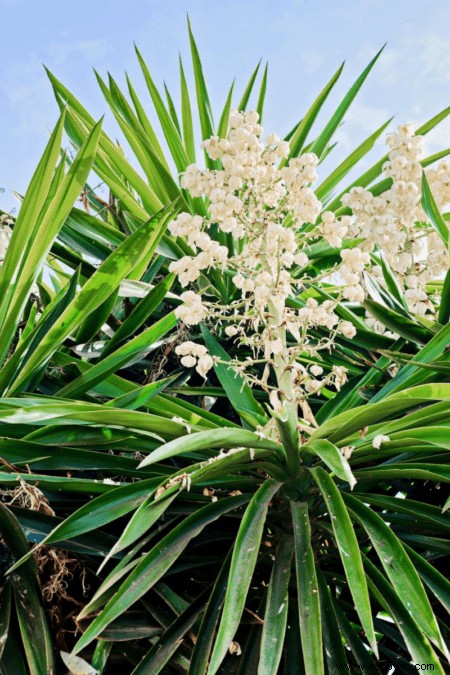 La especie Yucca, aunque bastante similar en apariencia y hábitos de crecimiento, es popular para muchos diseños de paisajes. . Originarios de climas áridos y desérticos, en realidad crecen muy bien en todas las zonas y son tolerantes tanto a temperaturas bajo cero como a los altos calores del desierto. Las hojas rígidas en forma de espiga son caducas y las flores altas en forma de campana que muchas producen son una excelente adición a las camas de su jardín. También son una opción obvia para la xerojardinería para agregar textura y altura.
La especie Yucca, aunque bastante similar en apariencia y hábitos de crecimiento, es popular para muchos diseños de paisajes. . Originarios de climas áridos y desérticos, en realidad crecen muy bien en todas las zonas y son tolerantes tanto a temperaturas bajo cero como a los altos calores del desierto. Las hojas rígidas en forma de espiga son caducas y las flores altas en forma de campana que muchas producen son una excelente adición a las camas de su jardín. También son una opción obvia para la xerojardinería para agregar textura y altura.
La naturaleza caduca de ellos proporciona vegetación y textura durante todo el año y, como se mencionó, son muy fáciles de cuidar debido a su bajo mantenimiento. Prosperan en suelos pobres y bien drenados y requieren poca o ninguna fertilización.
Cuidando tu yuca
La yuca es una de las pocas especies que puedes plantar y más o menos alejarte. Más que nada, debe prestar atención a los suelos en las plantaciones iniciales para asegurarse de que el agua pueda drenarse fácilmente. La única amenaza real para la planta es la pudrición de la raíz debido al agua que se acumula en las raíces, y es posible que desee mezclar la tierra con arena en un área equivalente a 2 o 3 veces el tamaño del cepellón antes de plantar.
Agua
Una vez plantado, solo necesita regar hasta que esté establecido, y después de eso, la lluvia que reciba en su área probablemente será suficiente. Asegúrese de consultar con la especie que planta para asegurarse de brindarle cualquier atención especializada que pueda tener.’
Las plantas de interior también deben plantarse con cuidado en suelos bien drenados. Y solo riegue cuando esté completamente seco, después de lo cual debe verter o drenar el exceso de agua. Puede limpiar el polvo de las hojas con un paño húmedo, podar los bastones de flores muertas o las hojas y proporcionar un fertilizante líquido soluble en agua balanceado una o dos veces al año, generalmente en primavera y mediados de verano.
Luz
Las yucas prosperan a plena luz del sol, pero también pueden tolerar la sombra parcial. Pero la regla general es que cuanto más sol, mejor. Cuando tenga plantas en el interior, asegúrese de mantenerlas en una ventana soleada o proporcione algún tipo de luz para crecer durante parte del día.
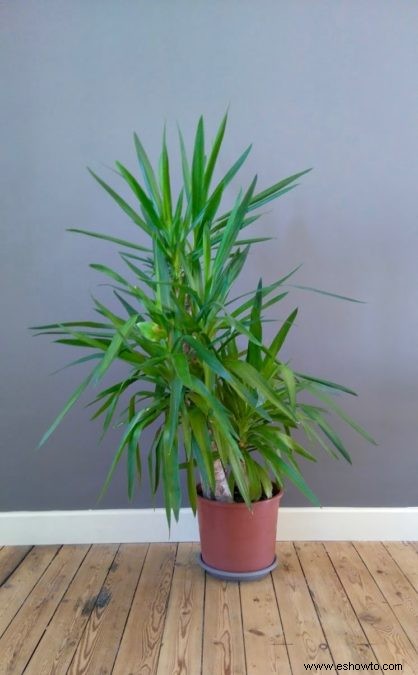 Ubicación
Ubicación
Casi todas las especies tienen hojas de punta afilada. Estos son muy afilados y pueden perforar fácilmente la piel. Cuando los plantes, debes tener cuidado de colocarlos lejos de los pasillos y áreas de alta actividad para evitar accidentes.
Propagando Yuca
Yucca is easy to propagate and if left alone, will quickly multiple via seed and root. In order to purposely propagate your own yucca you do so via various ways. Yuccas typically begin to spread outwards with new, young plants. You can separate these plants off and move where you want them. You can also root and stem cuttings, as well as plant seeds.
When planting offsets, strip the bottom few inches of leaves before placing in the soil. However, cutting from the rhizome root-like structure is probably the easiest way to get plants sprouting up where you want them. Simply dig up a section of rhizome and cut into 3 pieces- then plant where you want them to come up in about a month.
Mature Plant Care
Yuccas truly don’t require much care once planted and established, but you should keep it cleaned up as much as possible. Remove any dead or dying leaves, which will show from the bottom as the plant grows and regenerates. Also, remove the stalk after blooming, unless you want the plant to reseed itself. The seeds will scatter and come up in places you don’t expect.
If you don’t want the plants to self-propagate, be sure to remove the stalks when the seed-pods are still young. Also dig up any young plants from the root, and pour salt at the site of the root to keep it from resprouting. These are a fairly slow growing plant that takes 2 to 3 years to mature, or longer, so it is easy to keep on top of plant control.
Popular Yucca Varieties
There are many different yucca species, and all are fairly similar to one another overall. Because of this identifying them is a challenge for many people unless there are distinct defining characteristics, such as a trunk or flower color. The following variety are the most commonly seen in landscape plantings and indoor propagation.
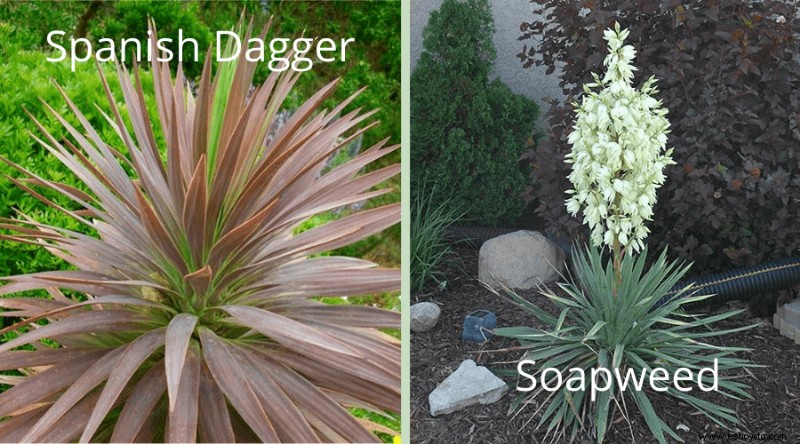
Spanish Dagger (Yucca aliofolia)
This is a great option for upright interest as it can grow between 6 and 12 feet tall on an upright stem. Most hardy in zones 7 -11, it is definitely a plant for outdoor gardens or large sunroom and greenhouse additions.
Soapweed (Yucca arkansana)
Not quite as rigid in nature as other types, and they also are not as wide overall. They grow upright without a trunk and are good for both indoor and outdoor propagation.
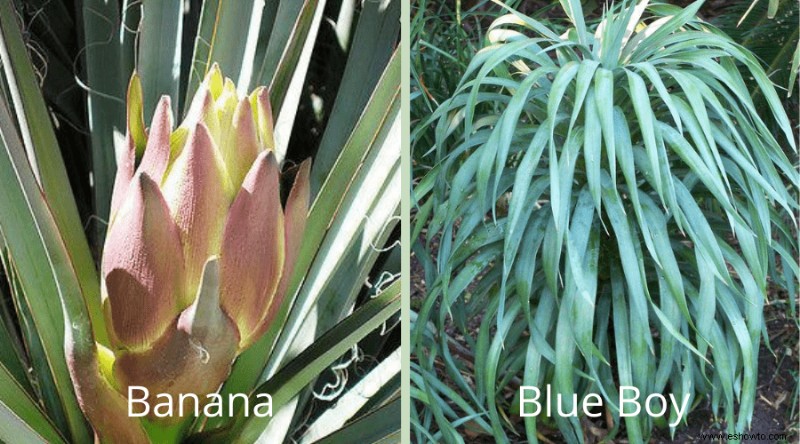
Banana Yucca (Yucca baccata)
The Banana Yucca is probably the most popular outdoor yucca species. It grows up to 3 feet wide and tall and sends a 4 to 5 foot tall stalk that produces clusters of white flowers. It reseeds easily and will grow in clusters of plants if allowed.
Blue Boy Yucca (Yucca desmetiana)
The long, blue-tinged, leathery leaves of the Blue Boy doesn’t have as sharp a tip and makes it an ideal planting for both indoors and outdoors. It grows well in pots, and also makes a beautiful border.
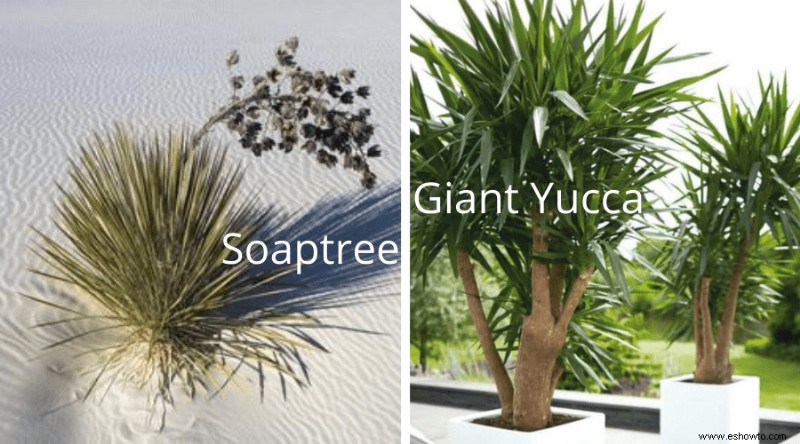
Soaptree Yucca (Yucca elata)
This tall, tree like yucca is great for vertical interest and can grow up to 20 feet tall. It also sends out tall stalks that fill with white, bell shaped flowers. When not in bloom it resembles a small palm looking tree.
Giant Yucca (Yucca gigantea)
The broad leafed, spineless leaves of the giant yucca makes it a popular indoor and outdoor planting. It grows on a trunk that branches over time and can grow up to 40 feet in height. When grown indoors it rarely gets over 10 feet tall.
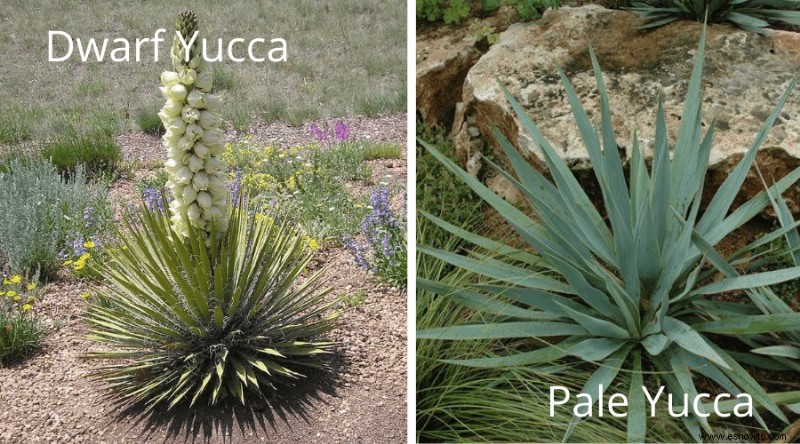
Dwarf Yucca (Yucca nana)
With a growth habit of approximately 1 foot by 1 foot, this small yucca is a popular planting in both indoor and outdoor displays. It also looks great in a pot, despite it’s sharp, spined tips. They are often clustered together or used as a border.
Pale Yucca (Yucca pallida)
The pale green and bluish leaves of this yucca, and smaller growth habit makes it a great choice for indoor and outdoor pots and gardens. It only gets about a foot in height, but can grow up to 3 feet wide, and will cluster together if allowed to naturally propagate.
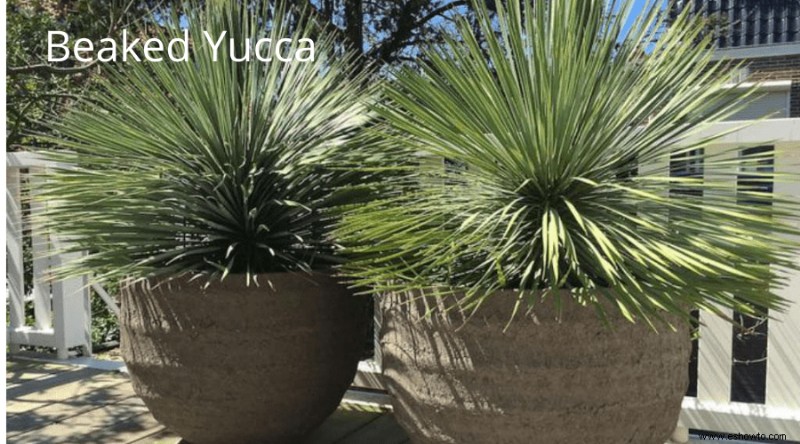
Beaked Yucca (Yucca rostrata)
This is one of the most popular upright yuccas you can plant in your garden. Tree-like in nature, the leaves grow in a tight globe display for an aesthetically pleasing effect. It also grows well in pots and is a great addition to indoor sunrooms and greenhouses.
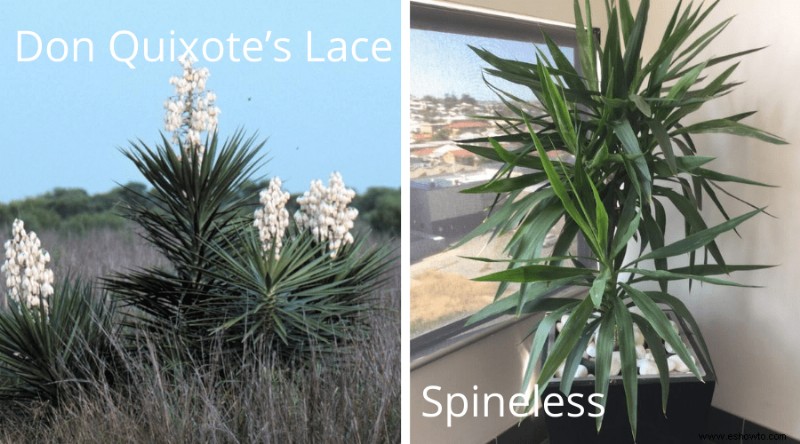
Don Quixote’s Lace Yucca (Yucca treculeana)
The upright growth of this yucca is almost treelike, and it reaches up to 12 feet tall, and 10 feet wide. As it grows the old leaves create a bushy undergrowth and bright 3 foot long leaves and spear-like flower stalks reach upwards upon maturity.
Spineless Yucca (Yucca elephantipes)
The wider, thinner, and softer leaves of the spineless yucca still have a slightly sharp tip, but are much more comfortable to work around than other popular species. Because of this it is a very popular indoor plant, and grows on a trunk in an upright position.
Purchasing
Yuccas are naturally growing plants in many southern and western states, but do grow well elsewhere. If you are looking to grow your own, look to local plant nurseries for plants that do well in your climate. If they do not have what you are looking for, many online nurseries are happy to ship root cuttings and small plants for you, and will answer any questions you have about their survival in your area.
Common Questions Gardeners Have About Yucca Plants
Despite being an incredibly easy plant to grow, there are a few common questions people have about them. These are some of the more frequently asked questions concerning their health and care.
What diseases and bugs do yuccas get?
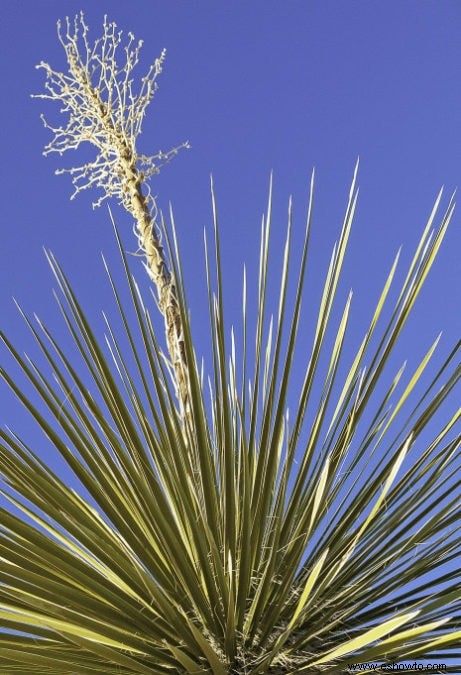 Luckily, yuccas do not draw in many insects nor are they very susceptible to disease. However there are a few things to pay attention to if you notice the following:
Luckily, yuccas do not draw in many insects nor are they very susceptible to disease. However there are a few things to pay attention to if you notice the following:
- Brown spots 2 to 3 centimeters in diameter caused by a fungus. Simply remove the leaves these show up on and spray the plant with a fungicide.
- Gray leaf lesions may show up on older leaves. Again, simply remove them and spray with a fungicide.
- Necrotic tips may occur due to a nutrient loss in the soils. It will show up on the tips and edges of the leaves, but will not harm the plant. You can add lime to the soil to help offset this.
- Stem rot, marked by a blackening or decay towards the bottom of the plant. This is generally due to too much water that begins to rot the plant and introduce bacteria. Once a plant shows this, it may be too late to salvage.
- Sclerotia is a fan like bacteria seen on the stem near the base of the plant. A fungicide can help control it.
- The types of bugs that you may have issues with are all sucking type bugs such as aphids, agave plant bugs, mealybugs, scale, and mites. If you notice you plant not thriving, or any of these bugs on them, simply spray with a Neem oil to control.
- Weevils are the most problematic insects and burrow into the crown of the plant. Most yuccas are never bothered by this as weevils attack weak and ailing plants. Once your plant has them it is almost impossible to get rid of them.
What do I feed Yucca plants?
Yuccas in the wild are fed by nothing but nature, but when you plant them in the garden or in your home, you may want to feed them once or twice a year. In general use a balanced liquid soluble fertilizer in the spring, and again in the summer if you want.
How do I get rid of Yucca plants?
Sometimes yuccas can get a bit too big and unruly. This is especially so if they are native to your area and grow like weeds. Yuccas are notoriously hard to get rid of since they propagate from the root system and send out hundreds of seeds. However, if you are determined to wipe them out (or just keep them under control) you need to get them up by the root and try to get all the rhizomes. Putting salt on the root can help dry it out and keep it from growing back.
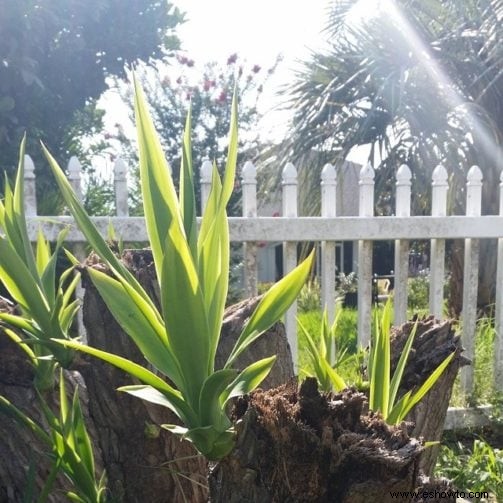
Are Yucca plants dangerous?
The sharp points of the Yucca can certainly be very uncomfortable and cause all sorts of discomfort when you get pricked or scratched from one, but rarely are they deep enough to cause any issues. If you do happen to get one that draws blood, simply clean with soap and water and keep it clean. When working with them, always wear long sleeves and gloves for protection.
However, if you dog or cat chews on the plant or ingests any of it they most likely will be poisoned by the steroidal saponins that create intestinal irritation and central nervous system issues in large enough doses. Drooling, vomiting, weakness, seizures, and dilated pupils are indications of the poisoning. If you think your pet has consumed any yucca, early detection is best for a full recovery and you need to get to a vet ASAP.
Conclusión
The bottom line is, yuccas are crazy easy to grow whether you put them indoors or out. They are also incredibly easy to propagate and you may find you have more plants than you planned on before too long. Luckily, they are fairly easy to control if you take care of young plants before they get too large.
We’d love to answer any questions you may have, and see how you have landscaped with these unique plants that bring a ton of interest and texture to your home. As always, please share!

